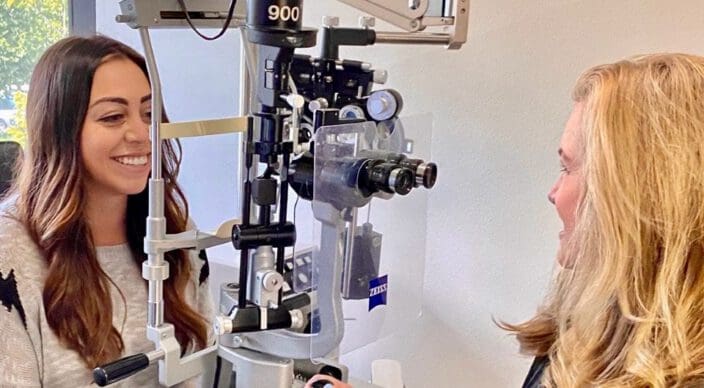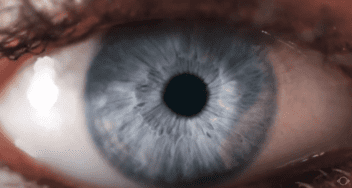Laser Iridotomy: Overview, Costs & Success Rates
Home / Diagnosed With Glaucoma /
Last Updated:
Table of Contents
Laser iridotomy is used in the treatment of acute angle-closure glaucoma. A doctor uses a laser to cut open a small hole in the iris, allowing built-up intraocular fluid to drain out and restore normal pressure levels to the eye.
It is a very safe and successful procedure, but it needs to be done as soon as the patient or doctor notices that intraocular pressure is too high. Patients should continue receiving glaucoma treatment after the procedure.
The Angle
In laser iridotomy, the “angle” is the angle between the iris (the colored part of the eye) and the cornea, the clear window in front of the eye. The narrower the angle, the more limited the flow of fluid from the eye. This causes the fluid to back up, increasing the internal pressure on the eye.

The increase in eye pressure can cause pain and discomfort in the eye, vision loss, and possible damage to the optic nerve. If left untreated, this can cause blindness.
You deserve clear vision. We can help.
With 135+ locations and over 2.5 million procedures performed, our board-certified eye surgeons deliver results you can trust.
Your journey to better vision starts here.
The angle, the space between the cornea and the iris, contains the trabecular meshwork. When working properly, this structure pumps fluid out of the eye. Doctors can use a gonioscopy test to measure the angle and make sure it is broad enough to let the trabecular meshwork do its job.
During a laser iridotomy, the laser light creates a small hole in the iris, which leads to an increase in the angle between the iris and the cornea. This exposes the trabecular meshwork, encouraging fluid outflow.
In the past, this was done by using scissors in an operating theater, but the development of laser technology allows for perfect precision in cutting a hole into the eye and improving vision.
When Is Laser Iridotomy Used?
Laser iridotomy is recommended for patients whose angle is closed for at least half of the affected eye. Patients who also have risk factors for high blood pressure, diabetes, or glaucoma will also qualify for laser iridotomy.
For patients who have a closed angle but normal pressure in their eyes (and no damage to their optic nerve), a doctor may recommend doing laser iridotomy as a preventative measure.
Getting Laser Iridotomy

Before the procedure, patients are given eye drops that make their pupil small. Then, they are given anesthetic drops to numb the surface of their eye. A doctor will place a lens on their eye, and the laser will then go to work.
Laser iridotomy usually takes no longer than 10 minutes. Some patients may feel a small amount of pain on their eyes while the laser cuts an opening in their iris.
Laser iridotomy will cause blurriness in vision, but this is only temporary. Patients might notice that their treated eye is a little red and sensitive to light. They may also have a mild headache.
A doctor will measure the pressure in the eye anywhere from 30 minutes to 2 hours after the surgery. Anti-inflammatory eye drops will be prescribed for a few days after the surgery as well. Patients can go home the day of their operation, but they cannot drive or do any vision-intensive tasks.
Risks & Limitations
It is important to note that laser iridotomy is not meant to improve vision. It is only performed to prevent glaucoma from developing or progressing.
As with most medical procedures, there is some amount of risk with laser iridotomies. Some of the risks include bleeding at the laser site, inflammation, and even an increase in eye pressure. In most cases, these side effects are temporary. Some patients might experience flashes, bright lights, or double vision in the treated eye; however, these effects are relatively rare.
You deserve clear vision. We can help.
With 135+ locations and over 2.5 million procedures performed, our board-certified eye surgeons deliver results you can trust.
Your journey to better vision starts here.
Costs & Success Rates
Laser iridotomy is usually very successful, but it can fail to sufficiently open the angle in about one out of four cases. Depending on the factors of the case, patients might need more laser treatment, medications, or surgery.
The Korean Journal of Ophthalmology writes that the sooner a patient is treated with laser iridotomy after a diagnosis, the better the chances of the procedure being successful long term.
The cost of the procedure ranges from $1,250 to $1,650.
Effectiveness & Ongoing Treatment
Laser iridotomy is not a replacement for glaucoma medication. Patients should continue to take their prescribed glaucoma eye drops until directed otherwise by their doctor.
The angle between the cornea and the iris usually widens enough after the laser treatment, but as patients age, it may be normal for the angle to start closing again. This is especially the case if cataracts develop because the inactive proteins that form on the lens of the eye could close the angle again. Cataract surgery would be required to remove the obstructions before the intraocular pressure starts building up again.
Acute Angle-Closure Glaucoma
Laser iridotomy is the treatment of narrow angles, acute angle-closure glaucoma, and chronic angle-closure glaucoma. Acute angle-closure glaucoma is a serious problem, causing irreversible vision loss. A patient who has this form of glaucoma must receive laser iridotomy as soon as possible.
Acute angle-closure glaucoma is a form of glaucoma where the angle between the cornea and the iris is mostly closed, redirecting the eye’s internal fluid backwards. This can happen suddenly, in an acute attack, or gradually.
There are also other forms of the disease where the angle can be too narrow or even closed, but the internal eye pressure is not problematically high, and the optic nerve is unaffected. However, even in this case, a patient should seek treatment to open up the angle again.
You deserve clear vision. We can help.
With 135+ locations and over 2.5 million procedures performed, our board-certified eye surgeons deliver results you can trust.
Your journey to better vision starts here.
References
- Acute Closed Angle Glaucoma. (January 2020). StatPearls Publishing.
- ‘Narrow Angles’: A Tip-Off to Eyesight Risk. (April 2006). Harvard Medical School.
- Understanding Trabecular Meshwork Physiology: A Key to the Control of Intraocular Pressure? (October 2003). Physiology.
- Angle Closure: PIs vs Cataract Surgery. (April 2017). Review of Optometry.
- Is Laser Peripheral Iridotomy Painful? (September 2020). Medicine Net.
- Prognostic Factors for the Success of Laser Iridotomy for Acute Primary Angle Closure Glaucoma. (December 2009). Korean Journal of Ophthalmology.
This content is for informational purposes only. It may have been reviewed by a licensed physician, but is not intended to serve as a substitute for professional medical advice. Always consult your healthcare provider with any health concerns. For more, read our Privacy Policy and Editorial Policy.

